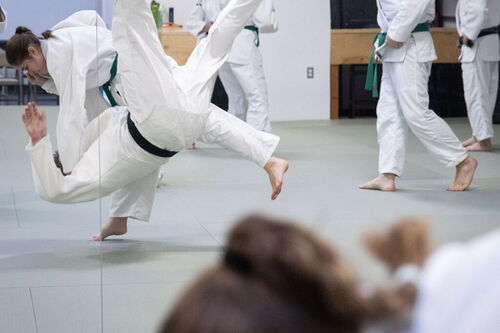How to Fall Correctly: A Video Breakdown and Guide
How to Fall Correctly - The Ultimate Guide! Intro to Ukemi
Want to minimize your risk of injury while practicing martial arts?
Nervous you’ll accidentally hurt yourself during a drill?
Ukemi, the art of falling safely and efficiently, is an essential skill in martial arts like Judo, Aikido, and Jujutsu. Proper ukemi not only prevents injuries but also enhances overall martial arts performance. This guide breaks down the key elements of ukemi based on our video How to Fall Correctly - The Ultimate Guide! Intro to Ukemi, offering detailed steps and exercises to help you improve your falling techniques and self-defense in Ann Arbor.
1. Protect Your Head
The first rule of ukemi is to protect your head. Keeping your head forward and your chin tucked is crucial. Your head should never be the first point of contact with the ground. Instead, it should be the last, ensuring that all the force is dissipated through other parts of your body.
Exercise: Grab your knees, tuck your chin, and roll forward several times. Focus on keeping your eyes forward and your head stable. This practice helps in maintaining control and preventing the head from rocking backward during a fall.
2. Master the Art of Slapping
Slapping the ground with your arms during a fall helps to disperse the impact force, reducing the risk of injury. This technique involves extending your arms in a "V" shape rather than a plus sign, which helps maintain balance and protect the head.
Exercise: Practice gentle slapping from shoulder to fingertip while on your knees. Ensure your knees are slightly bent and pointing straight ahead. Progress to two-hand back falls with your chin tucked and feet extended.
Common Mistakes to Avoid:
Head going back: Always keep your chin tucked.
Timing of the slap: Avoid slapping too early or too late; synchronize it with your upper body hitting the ground.
Disorganized feet: Keep your legs together and pressed gently.
3. Practicing One-Handed Back Falls
In many martial arts scenarios, one of your hands might be restrained. Practicing one-handed backfalls helps in preparing for such situations. Focus on rocking slightly to one side and maintaining control of your head and body.
Exercise: Perform one-handed back falls, looking at the free hand and rolling to that side of the body—practice on both sides for balanced skill development.
4. Side Falls and Rolling Falls
For effective side falls, ensure your hands and feet are correctly organized. The bottom leg should be slightly bent, and the side of the foot should hit the ground along with the whole leg.
Exercise: From a side fall position, practice switching sides. Maintain a gentle bend in the legs and activate your abdomen to keep control of your body. Progress to more agile and acrobatic movements as you become comfortable.
5. Standing Back Falls
Standing back falls involve falling from a greater height. The key is to avoid falling like a tree, which can be traumatic. Instead, aim to sit back as much as possible, almost as if you are trying to sit on your heels.
Exercise: Practice standing back falls by sitting first and then slapping. Repeat the movement in three sets, focusing on keeping your chin tucked and maintaining control of your torso.

6. Handling Sweeps
When your foot gets swept during a practice or match, it's crucial to fall correctly. This involves a controlled sit rather than an uncontrolled fall.
Exercise: Perform a one-handed backfall by sweeping your lead foot across and sitting on your heel. Practice with both hands and incorporate movement to simulate real-time scenarios.
7. Forward Rolling Falls (Ukemi)
Forward rolling falls, or airborne ukemi, are vital for advanced martial arts practice. These falls allow you to stay relaxed, pay attention to your surroundings, and reduce the risk of injury.
Basic Exercise: Start in a low position with a wide stance and bent knees. Create a wheel with your hands and roll forward, slapping with your hands and feet. Maintain a round shape in your arms and upper body to facilitate smooth rolling.
Advanced Exercise: Progress to standing rolls and practice different variations, including those without slapping for a smoother finish. Incorporate long-distance jumps, height jumps, and acrobatic flip jumps to build complexity and awareness in the air.
Falling Safely is Necessary for Self-Defense in Ann Arbor
Ukemi is not just about falling; it's about falling well.
By mastering these techniques, you can improve your overall martial arts skills, stay safe, and become more confident in your self-defense in Ann Arbor. Remember, practice is key. Start slowly, focus on form, and gradually increase the intensity as you become more comfortable. Safe falling!
Contact us if you’d like to practice properly on our spring-board floors!
